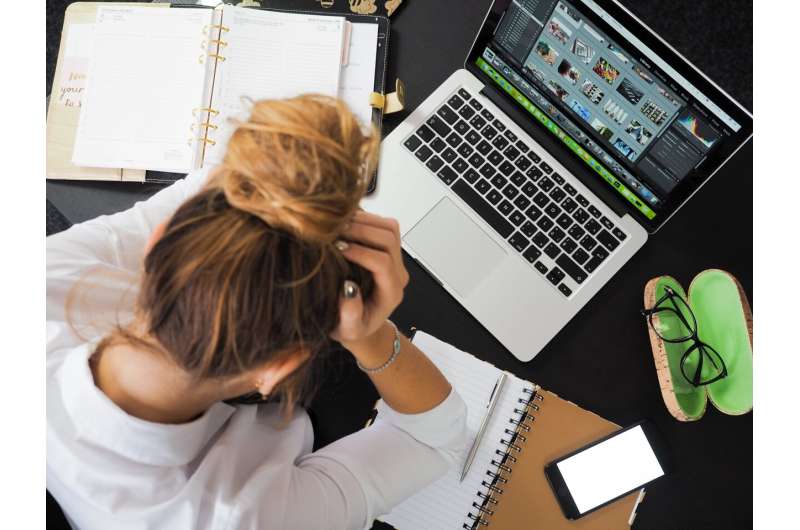This article has been reviewed according to Science X's editorial process and policies. Editors have highlighted the following attributes while ensuring the content's credibility:
fact-checked
trusted source
proofread
Mental health in the workplace is an ongoing challenge

In Quebec workplaces, psychological distress and psychotropic drug use have fallen back to prepandemic levels, but symptoms of depression, anxiety and burnout have become more widespread.
That's according to the latest data from a longitudinal study by the Observatory on Health and Well-Being at Work (OSMET), led by professor Alain Marchand of Université de Montréal's School of Industrial Relations.
The study launched in 2019 to track the changing mental health of 6,602 people in 95 Quebec workplaces. The data was compiled in cycles that covered different workplaces over different periods: 2019–2021 (cycle 1), 2020–2022 (cycle 2) and 2021–2023 (cycle 3).
By the time cycle 3 began, 38.6% of all respondents reported feelings of psychological distress, while 12 to 15.9% reported symptoms of depression or anxiety, 25.4% reported burnout and 22.4% used psychotropic drugs.
Back to prepandemic levels
First the good news: in general, rates of psychological distress have dropped back to where they were before the COVID-19 pandemic.
Distress among men remained practically unchanged throughout the study, having gone from 34.4% to 35% between cycle 1 and cycle 3. Among women, the rate rose from 38.9% to 41.3% over the same cycles, peaking at 44.8% in cycle 2.
Looking at the different age groups, all genders combined, youth between the ages of 18 and 34 reported the highest incidence of psychological distress: 40.5% in cycle 1, 50% in cycle 2 and 45.3% in cycle 3.
In contrast, psychological distress affected just one in three people aged 50 and up.
Burnout remains an issue
Overall, burnout rates were approximately the same in cycles 1 and 3, after dropping sharply in cycle 2, the pandemic years.
Fewer than one in four men (23%) felt burned out in cycles 1 and 3, while fewer than one in five (19%) reported feelings of burnout in cycle 2. Meanwhile, the rates for women were 28% in cycle 1, 24.8% in cycle 2 and 26.5% in cycle 3.
Once again, burnout was most common among youth between 18 and 34 (rising from 27.4% to 30.5% over the three cycles). Adults between the ages of 35 and 49 came in second (with rates falling from 29.7% to 27.8% over the same time frame).
Depression and anxiety a concern
Between cycles 2 and 3, depression increased among all respondents, all ages and genders combined. Women (17.3% in cycle 3), adults aged 35–49 (17%) and 18–34 (23.1%) reported the most symptoms. But the biggest jumps between these two cycles were seen among men (9.9% to 13.4%) and adults aged 35–49 (14% to 17%).
Symptoms of anxiety mostly affected adults aged 18–34, with rates holding at 19% over cycles 2 and 3. Although anxiety stayed relatively unchanged among women (11.7% to 13.2%) over the same period, the biggest rise was seen among men (8.1% to 11.5%).
Finally, consumption of psychotropic drugs remained more or less the same over all three cycles. Of the respondents, women and adults aged 50 and up used these drugs the most (25.2% in cycle 3 for both groups).
Challenging for women and youth
According to Marchand, mental health for women and youth is particularly concerning.
"When we look at these numbers over time, psychological distress and burnout appear to have been influenced by conditions related to the COVID-19 pandemic that mainly started to appear in cycle 2," he said. "But the data suggests that these changes were specific to the pandemic, since the indicators went back to prepandemic levels in cycle 3."
He added that the combined effects of lockdown, fear of contagion and the need to work from home seemed to dissipate over time, once the spread of the disease came under control and people started to go back to in-person work, whether full-time or on a hybrid schedule.
But the increase in symptoms of depression and anxiety observed in men between cycle 2 and cycle 3, and symptoms of depression in adults aged 35–49, is worth keeping an eye on, Marchand said.
"We still need to analyze the data so we can understand these changes, but men may have had a harder time going back to work, with all the complications that commuting brings, while adults aged 35–49 may once again be finding it difficult to achieve a healthy work-life balance."
Provided by University of Montreal




















